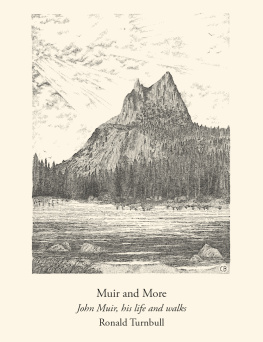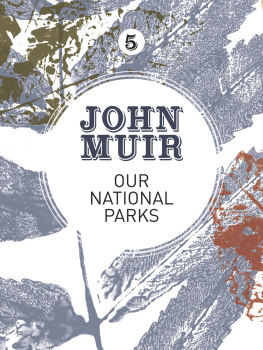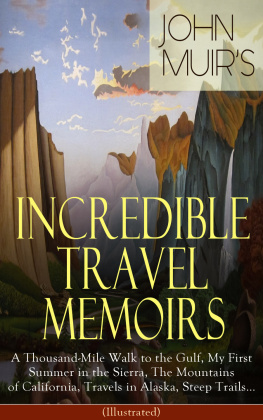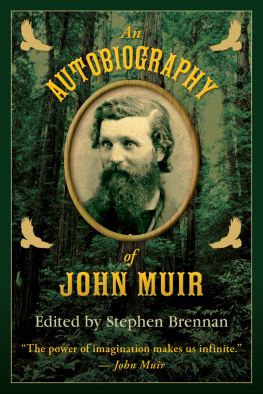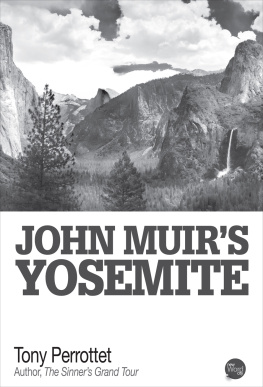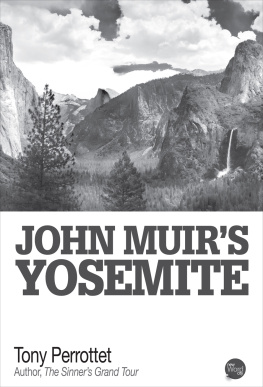JOHN MUIR

JOHN MUIR
West Coast Pioneer
DARYL ASHBY

JOHN MUIR: WEST COAST PIONEER
Copyright 2005 Daryl Ashby
All rights reserved. No part of this publication may be reproduced, stored in a
retrieval system, or transmitted, in any form or by any means, without prior written
permission of the publisher, or, in Canada, in the case of photocopying or
other reprographic copying, a licence from Access Copyright (The Canadian
Copyright Licensing Agency).
RONSDALE PRESS
3350 West 21st Avenue
Vancouver, B.C., Canada
V6S 1G7
Edited by Ronald B. Hatch
Typesetting: Julie Cochrane, in New Baskerville 11 pt on 15
Cover Design: Julie Cochrane
Cover Image: E.J. Hughes, Trees, Sooke Harbour (1951)
Frontispiece: John Muir, c. 1880, courtesy of Diane Alexander
Paper: Rolland Enviro Cream (100% recycled)
Ronsdale Press wishes to thank the Canada Council for the Arts, the Government
of Canada through the Book Publishing Industry Development Program
(BPIDP), and the Province of British Columbia through the British Columbia
Arts Council for their support of its publishing program.
Library and Archives Canada Cataloguing in Publication
Ashby, Daryl, 1948
John Muir: West Coast pioneer / Daryl Ashby.
Includes bibliographical references.
ISBN 1-55380-027-3
1. Muir, John, 1799-1883. 2. Vancouver Island (B.C.). Legislative Council
Biography. 3. Vancouver Island (B.C.). House of Assembly Biography.
4. Legislators British Columbia Vancouver Island Biography.
5. Coal miners British Columbia Vancouver Island Biography.
6. Lumbermen British Columbia Vancouver Island Biography.
7. Pioneers British Columbia Sooke Biography. 8. Sooke (B.C.)
Biography. I. Title.
FC3845.S6Z49 2005 971.1'2802'092 C2005-905900-1
At Ronsdale Press we are committed to protecting the environment. To this end
we are working with Markets Initiative ( www.oldgrowthfree.com ) and printers to
phase out our use of paper produced from ancient forests. This book is one step
towards that goal.
Printed in Canada by AGMV Marquis
ACKNOWLEDGEMENTS
A SINCERE THANKS goes out to Carol Punt, Val Gillespie and my mother Evelyn Ashby for enduring the pain of reading my first draft and having the courage to suggest I continue for no matter how long it took. Many thanks also to Diane Alexander the great-great-granddaughter of John Muir, Sr., who entrusted me with her personal archives of the Muir familys history, for without her assistance this account would have been far less complete. Much credit goes to Darren Smith for his constructive criticism in the early stages of the manuscript; without it I would still be floundering in an ocean of disjointed thoughts. Audrey McClellan took the rough manuscript and steered me through far more redrafts than I care to remember. Catherine Whitehead did a final proofing. Possibly the most deserving of all is Ronald Hatch of Ronsdale Press. Where so many other publishers hesitated and procrastinated, Ronsdale stepped up to the plate and took control of the project, seeing it through the final editing process. Lastly and most importantly, my wife Wendy encouraged me on a day-to-day basis. When our social lives took a back seat to researching every aspect of the Muirs existence, she never complained but jumped into the trenches alongside me and helped unearth every fragment of the Muir familys history we could lay our hands on.
CONTENTS
INTRODUCTION
John Muirs contribution to the political maturity and commercial prosperity in the formative years of British Columbia has never been recognized for its importance. The Muir family, proud, independent Scots, with the capacity to dream, were raised to believe that they had to rely on their own abilities to get ahead in life. When they arrived at the end of the 1840s in what was then called Vancouvers Island, they were determined to make a success of their new venture. John was already close to fifty years of age, but through determination and practical skills, and with the help of his wife and sons, he set British Columbia on the path that it has traversed to the present day. It might well be said that no other man in those early days did so much with so little.
In the 1840s John Muir was living with his wife Ann and their five children in the small town of Kilmarnock, Scotland, made famous through its association with Robert Burns. Nineteenth-century Scotland was not an easy place to make a living, especially if, like the Muirs, one eked out a meagre living as coal miners in a land where class boundaries were hard to break. But John Muir had imbibed the Burns sentiment of a mans a man for a that, and to put the ideal into practice, he decided to emigrate to a land where there was more opportunity for the working man.
In late 1848 he responded to an advertisement for land in a place that he had never heard of: Vancouvers Island, on the western edge of North America. The advertisement said that good land was available for 1 per acre, the minimum allotment being 100 acres. It sounded exciting, but 100 was far too steep a price for the Muirs, who were by no means of the gentry or landed class, and they decided on the other option offered.
This was to go out to the new land as consignee workers with the Hudsons Bay Company. The agreement was that, in return for three years of work, they would be given a grant of twenty-five acres of land. As a mining family, the Muirs were extremely valuable to the Hudsons Bay Company, for it was searching at this time for a source of coal at Fort Rupert on the north end of Vancouver Island. As consignees the Muirs would also have their passage paid. It was clearly the best way, perhaps the only way, for the Muirs to manage their emigration.
After a difficult voyage from Great Britain lasting some six months, which took them around the Cape, John and his family stepped ashore at Fort Victoria in early June of 1849. On their arrival, they found little in the way of a welcome. Certainly the situation was not at all what they had been led to expect. The colonies of the Maritimes and Upper and Lower Canada were relatively well established by mid-century, but the colony of Vancouver Island had been created only shortly before their arrival in 1849 in fact after the time that the advertisement for land had appeared. What they came to was not an established colony, but a Hudsons Bay Company fort designed for the fur trade, with no town yet in existence. Moreover, it was a relatively new fort, having only recently celebrated its fifth anniversary. Aside from a few acres under cultivation and a couple of company farms to its credit, the settlement was still an outpost in its infancy.
At the time of the Muirs arrival, the fort remained the only evidence of the Hudsons Bay Companys occupation of the land. Any thought about roads, a permanent source of drinking water or any form of civilized housing would have been premature prior to the commitment of those like the Muirs who were to make the area their new home. Initially, there were no independent settlers, only Hudsons Bay Company employees.
It took the Muirs some time to understand the political and social situation in which they had landed. Fort Victoria had been built as a kind of backup to the main trading post, Fort Vancouver, on the Columbia River. The Hudsons Bay Company had maintained a post on the Columbia since 1811, and in the beginning it had assumed that the area surrounding the mouth of the Columbia would remain British. But then in 1818 a convention had been signed by Britain and the United States, wherein the northwest coast of America... shall be free and open for both parties to jointly occupy. When American settlers began arriving in great numbers, and it became clear that the British were outnumbered, the Hudsons Bay Company decided it was prudent to move further north.
Next page

